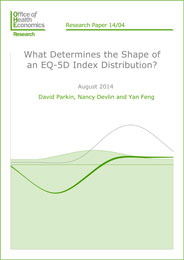Sign up to our newsletter Subscribe
Understanding the Full Value of Long-Acting Therapies: less is more?

The EQ-5D is one of the most used health-related quality of life instruments worldwide. Understanding the characteristics of its underlying data is essential. In this paper, OHE’s Nancy Devlin and Yan Feng join David Parkin from King’s College London in analyzing characteristics of…
The EQ-5D is one of the most used health-related quality of life instruments worldwide. Understanding the characteristics of its underlying data is essential. In this paper, OHE’s Nancy Devlin and Yan Feng join David Parkin from King’s College London in analyzing characteristics of the EQ-5D indexing process that may obscure useful, and important, information about health states.
Distributions of EQ-5D index values in patient and general populations typically divide into two distinct groups, the authors note. This might reflect the actual distribution of ill health, but it also might be an artefact of how the EQ-5D index is constructed. This paper examines the determinants of the shape of EQ-5D distributions, particularly the origins of the ‘two groups’ distribution.
The authors compare distributions of EQ-5D index values with distributions based on data that have not been weighted and with condition-specific indexes for the same patients. They find that concentrating on the EQ-5D index may obscure useful information about health states and possibly produce misleading information. They emphasise the importance of exploratory analysis of EQ-5D data – both to improve analyses of EQ-5D data for comparison and inference purposes, and to help develop more accurate mapping across different health measures.
For an overview of OHE’s extensive activities in patient-reported outcomes measures, please click here.
What Determines the Shape of an EQ-5D Index Distribution?

